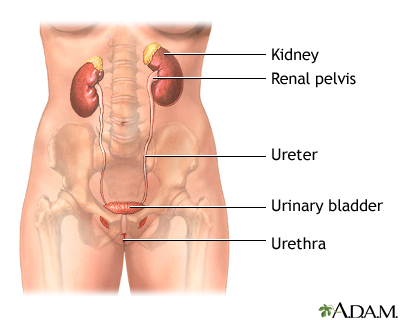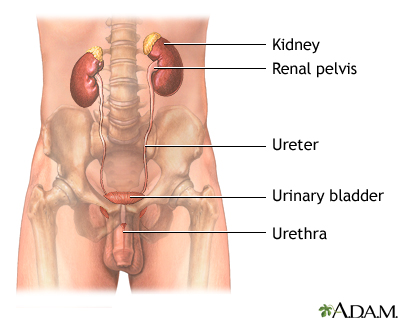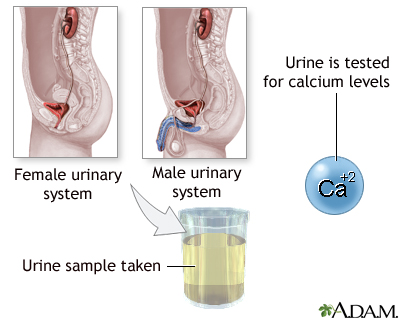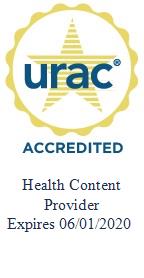Health Library
Calcium - urine
Urinary Ca+2; Kidney stones - calcium in urine; Renal calculi - calcium in your urine; Parathyroid - calcium in urine
This test measures the amount of calcium in the urine. All cells need calcium in order to work. Calcium helps build strong bones and teeth. It is important for heart function, and helps with muscle contraction, nerve signaling, and blood clotting.
See also: Calcium - blood
Images



I Would Like to Learn About:
How the Test is Performed
A 24-hour urine sample is most often needed:
- On day 1, urinate into the toilet when you wake up in the morning.
- Collect all urine (in a special container) for the next 24 hours.
- On day 2, urinate into the container in the morning when you wake up.
- Cap the container. Keep it in the refrigerator or a cool place during the collection period. Label the container with your name, the date, and the time you finish it, and return it as instructed.
For an infant, thoroughly wash the area where urine exits the body.
- Open a urine collection bag (a plastic bag with an adhesive paper on one end).
- For males, place the entire penis in the bag and attach the adhesive to the skin.
- For females, place the bag over the labia.
- Diaper as usual over the secured bag.
This procedure may take a few tries. An active baby can move the bag, causing urine to go into the diaper. You may need extra collection bags.
Check the infant often and change the bag after the infant has urinated into it. Drain the urine from the bag into the container provided by your health care provider.
Deliver the sample to the laboratory or to your provider as soon as possible.
How to Prepare for the Test
Many medicines can interfere with urine test results.
- Your provider will tell you if you need to stop taking any medicines before you have this test.
- Do not stop or change your medicines without first talking to your provider.
How the Test will Feel
The test involves only normal urination, and there is no discomfort.
Why the Test is Performed
Urine calcium level can help your provider:
- Decide on the best treatment for the most common type of kidney stone, which is made of calcium. This type of stone may occur when there is too much calcium in the urine.
- Monitor someone who has an overactive parathyroid gland, which helps control calcium level in the blood and urine.
- Diagnose the cause of problems with your blood calcium level or bones.
Normal Results
If you are eating a normal diet, the expected amount of calcium in the urine is 100 to 300 milligrams per day (mg/day) or 2.50 to 7.50 millimoles per 24 hours (mmol/24 hours). If you are eating a diet low in calcium, the amount of calcium in the urine will be 50 to 150 mg/day or 1.25 to 3.75 mmol/24 hours.
Normal value ranges may vary slightly among different laboratories. Talk to your provider about the meaning of your specific test results.
The examples above show the common measurements for results for these tests. Some laboratories use different measurements or may test different specimens.
What Abnormal Results Mean
A high level of urine calcium (above 300 mg/day) may be due to:
- Chronic kidney disease
- High vitamin D level
- Leaking of calcium from the kidneys into the urine, which may cause calcium kidney stones
- Sarcoidosis
- Taking too much calcium
- Too much production of parathyroid hormone (PTH) by the parathyroid glands in the neck (hyperparathyroidism)
- Use of loop diuretics (most commonly furosemide, torsemide, or bumetanide)
A low level of urine calcium may be due to:
- Disorders in which the body does not absorb nutrients from food well
- Disorders in which the kidney handles calcium abnormally
- Parathyroid glands in the neck do not produce enough PTH (hypoparathyroidism)
- Use of a thiazide diuretic
- Very low level of vitamin D
Related Information
Milk-alkali syndromeHypoparathyroidism
Proximal renal tubular acidosis
Sarcoidosis
Vitamin D
Malabsorption
Rickets
References
Bringhurst FR, Demay MB, Kronenberg HM. Hormones and disorders of mineral metabolism. In: Melmed S, Auchus RJ, Goldfine AB, Koenig RJ, Rosen CJ, eds. Williams Textbook of Endocrinology. 14th ed. Philadelphia, PA: Elsevier; 2020:chap 29.
Klemm KM, Klein MJ, Zhang Y. Biochemical markers of bone metabolism. In: McPherson RA, Pincus MR, eds. Henry's Clinical Diagnosis and Management by Laboratory Methods. 24th ed. Philadelphia, PA: Elsevier; 2022:chap 16.
Thakker RV. The parathyroid glands, hypercalcemia and hypocalcemia. In: Goldman L, Schafer AI, eds. Goldman-Cecil Medicine. 26th ed. Philadelphia, PA: Elsevier; 2020:chap 232.
BACK TO TOPReview Date: 7/23/2021
Reviewed By: David C. Dugdale, III, MD, Professor of Medicine, Division of General Medicine, Department of Medicine, University of Washington School of Medicine, Seattle, WA. Also reviewed by David Zieve, MD, MHA, Medical Director, Brenda Conaway, Editorial Director, and the A.D.A.M. Editorial team.
 | A.D.A.M., Inc. is accredited by URAC, for Health Content Provider (www.urac.org). URAC's accreditation program is an independent audit to verify that A.D.A.M. follows rigorous standards of quality and accountability. A.D.A.M. is among the first to achieve this important distinction for online health information and services. Learn more about A.D.A.M.'s editorial policy, editorial process and privacy policy. A.D.A.M. is also a founding member of Hi-Ethics. This site complies with the HONcode standard for trustworthy health information: verify here. |
The information provided herein should not be used during any medical emergency or for the diagnosis or treatment of any medical condition. A licensed medical professional should be consulted for diagnosis and treatment of any and all medical conditions. Links to other sites are provided for information only -- they do not constitute endorsements of those other sites. © 1997- 2022 A.D.A.M., a business unit of Ebix, Inc. Any duplication or distribution of the information contained herein is strictly prohibited.
